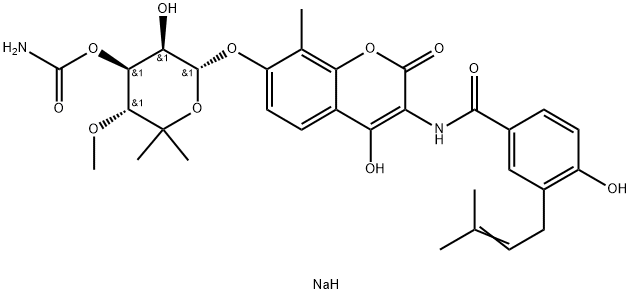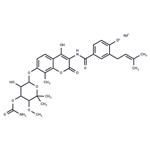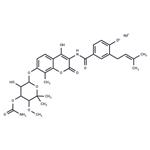Novobiocin is an antibiotic that acts as an inhibitor of bacterial DNA gyrase and eukaryotic DNA topoisomerase. Studies show that Novobiocin is also an inhibitor of retrovirus RNA-dependent DNA-polymerase. Novobiocin is used in the production of positively supercoiled plasmid DNA.
Novobiocin sodium salt is twice as bioavailable as the calcium salt and 50 times more available than the parent acid.
Topoisomerase II inhibitorNovobiocin sodium salt is effective an antistaphylococcal agent used in the treatment of Methicillin-resistant Staphylococcus aureus (MRSA). It is also used to inhibit the activity of retroviral RNA-dependent DNA polymerase as well as inhibitor of bacterial DNA gyrase and eukaryotic DNA topoisomerase.
Albamycin (Pharmacia & Upjohn).
Cell permeable: no', 'Primary Target
retrovirus RNA-dependent DNA polymerases', 'Product does not compete with ATP.', 'Reversible: no
The action of novobiocin is largely bacteriostatic. Itsmode of action is not known with certainty, though it doesinhibit bacterial protein and nucleic acid synthesis. Studiesindicate that novobiocin and related coumarin-containingantibiotics bind to the subunit of DNA gyrase and possiblyinterfere with DNA supercoiling and energy transductionin bacteria. The effectiveness of novobiocin is confinedlargely to Gram-positive bacteria and a few strains of P. vulgaris.Its low activity against Gram-negative bacteria is apparentlybecause of poor cellular penetration.
Although cross-resistance to other antibiotics is reportednot to develop with novobiocin, resistant S. aureus strainsare known. Consequently, the medical use of novobiocin isreserved for the treatment of staphylococcal infections resistantto other antibiotics and sulfas and for patients allergicto these drugs. Another shortcoming that limits the usefulnessof novobiocin is the relatively high frequency ofadverse reactions, such as urticaria, allergic rashes, hepatotoxicity,and blood dyscrasias.
Poison by
intraperitoneal and subcutaneous routes.
Moderately toxic by ingestion. Mutation data
reported. An antibiotic with serious side
effects which include liver and blood
disease. It may also promote the
development of resistant strains of
staphylococcus. When heated to
decomposition it emits toxic fumes of NOx
and Na2O.
The sodium salt has been recrystallised from MeOH, then dried at 60o/0.5mm. [Sensi et al, Anal Chem 29 1611 1957, Kaczka et al. J Am Chem Soc 78 4126 1956, Beilstein 18/8 IV 8125.]



